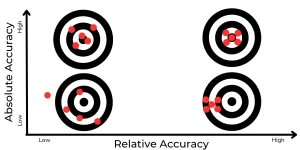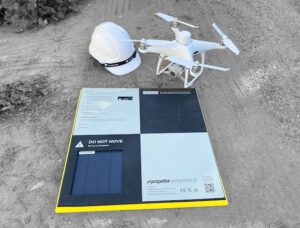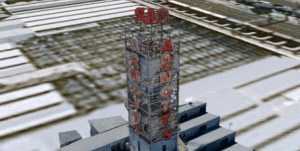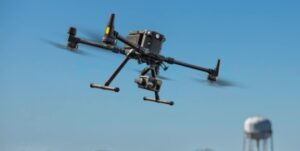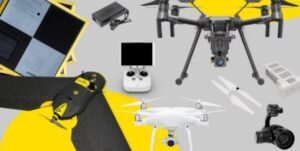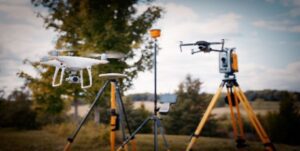How Drones are Redefining Stockpile Calculations at a Construction Site
Have you ever tried or tested traditional stockpile calculation methods like walking wheel, eyeballing, or counting bucket/truckloads or even hired a surveyor to calculate the stockpile at a project site? Even though they have been prevalent for a long time now, they all have a big drawback – they are very time consuming and costly calculation methods.
Construction companies use stockpile calculations to keep track of supplies and raw materials used in the project. Stockpiles are valuable assets for any company as they can later be monetized if left unused and intact.
Today, AEC companies use drones for land surveying, terrain mapping and stockpile calculations. It is becoming the go-to surveying workflow for construction sites and quarries in Australia, and rightfully so.
Why have a contractor spend an entire day on-site to measure the volume of a stockpile on-site when you can get precise stockpile measurements with the help of drones within hours. Plus, the data and information collected can be used for a variety of maps, models and reports that give you more valuable insights about the project or can be used for additional value.
As the Director of Operations and an avid drone enthusiast, I have worked with over a hundred AEC companies and I still get asked about the use of drones for construction projects and the potential benefits. In a report by PWC on the impact of drones, they state that the use of drones throughout a construction project provides an unparalleled record of all activities; cuts planning and surveys costs; increases efficiency and accuracy, and eliminates disputes over the status of a project at a given point in time. It’s no wonder drones are a terrific investment for construction companies.
In this blog, I will be discussing the role of drones in stockpile calculations and whether it is worth the trouble to invest in a company drone program or hire a professional drone services provider for the job.
Simpler, more manageable access to stockpile condition
Stockpile measurements help with financial forecasts and supply chain management.
I recently read a report published by the Frontier SI which discusses UAV data acquisition in Australia and New Zealand. A statement from this report struck a chord with me:
“Miners using UAVs typically require spatial resolutions of up to 3cm, and horizontal and vertical accuracy of less than 3cm and 5cm, respectively. The area of interest in this application is usually 2km or less, with the data acquired from a standard RGB camera.”
To explain, all you need is a commercial drone equipped camera, necessary permits and approvals plus surveying equipment to get stockpile measurements with centimetre accuracy!
In traditional stockpile measurements mentioned earlier, the land surveyor walks around the site and uses hundreds of points taken over the terrain and then joins these points to create a 3-dimensional model of the stockpile. This process can often take days and is prone to human errors and risks of traversing a project site.
AEC professionals have been known to use mobile phones to keep track of stockpile measurements. The land surveyor would mark the reference points around the stockpile using cones and use the cell phone to capture it from different angles. And while this is an improvement to manual surveys, this process still lacks the precision and efficiency of using drones.
Drones, in comparison, can get the job done in minutes. Plus, the benefits of using drones and photogrammetry is there are millions of points (pixels) that are measured as compared to hundreds of manual measurements taken by a land surveyor. In addition, the drone captures the stockpile or project sites from different aerial angles and can use the data for marketing, inspection or using photogrammetry software applications a 2D sitemap or 3D model of the stockpile is created and measurements and calculations can be performed.
Drone mapping allows frequent stockpile measurements
Using drone mapping, construction companies can survey and calculate stockpiles more frequently. Earlier, stockpile measurements involved much more manual set-up and process that took an entire day to traverse around a construction site with multiple stockpiles. This causes delays, risks and disruption to an active site and to your overall project.
Frequent stockpile measurements also improve your inventory management and logistics as you can keep track of the resources and see where and how they’re used throughout the project. Cost calculations are more precise given there is more frequent data.
Drone stockpile calculations save on costs and cut losses
A study by Kespry (a drone-based aerial intelligence platform) reveals that an industrial corporation saw an 84 per cent reduction in labour costs when they used drones for stockpile measurements.
Drone surveying in the construction sector is not limited to UAVs. Other surveying techniques involve 3D laser scanning and drone mounted LiDAR to scan stockpiles, terrain and replicate them as precise 3D models and maps.
These 3D models are then reviewed and analysed by AEC professionals to assess cut and fill calculations, evaluate site topography, compare stockpile volumes, drainage, design civil works, detect defects etc.
Drone stockpile measurements improve worksite safety
Land surveyors aren’t particularly excited about stockpile measurements. After all it is a cumbersome, time consuming and at times a dangerous job, especially on road projects, mining or quarries.
Earlier, the surveyor had to climb up a pile of raw materials to inspect the stockpile. Stockpiles are not stable; you can easily slip and fall from a height, leading to severe injuries.
Moreover, on busy construction sites, heavy machinery operates continuously. A simple mistake or laps in attention and the land surveyor can get hit by a truck, car or excavator. Drones improve worksite safety and get the job done in a shorter time.
Drones eliminate the need for a team of surveyors traversing the project site. A drone can be operated from a fixed position and at a safe distance. It’s even possible to stream the video footage live to engineers on the ground.
The bottom line
The benefits of drones in the construction sector are no hidden fact. With this technology, combined with some geospatial or surveying expertise, construction companies can make informed decisions about ordering raw materials, managing inventory etc.
Drone surveying provides quick answers, saves on time and resources and reduces operational downtime. It might be the best thing you can do for your construction project.
An in-house drone program is a great idea, providing you have the time and budget. Getting the appropriate licenses, insurances and experience takes time and money. Not too mention going through a drone adoption program only to have staff turnover set you back to square one.
I recommend you hire a professional drone surveying company to reduce the risk of repeated site visits and errors. Often, company employees start using drones to complement their existing work without the appropriate training, licenses or insurances and miss the intended benefits from outsourcing to a third party who has the knowledge, experience and capabilities to deliver on the scope of work and more. We see companies using drones, for simple tasks and completely overlook real benefits that are available. An experienced contractor should recommend related services or a methodology that provides the best possible outcome for the project and client objectives.
You can easily arrange for monthly, quarterly or annual inventory accounts. This is crucial if you have erodible raw materials or manage large earthworks volumes as part of your project.

